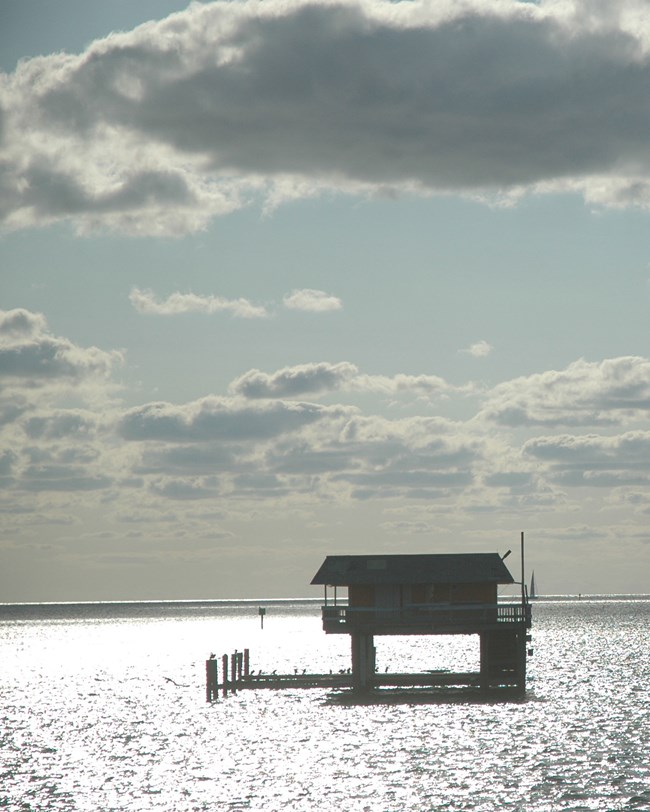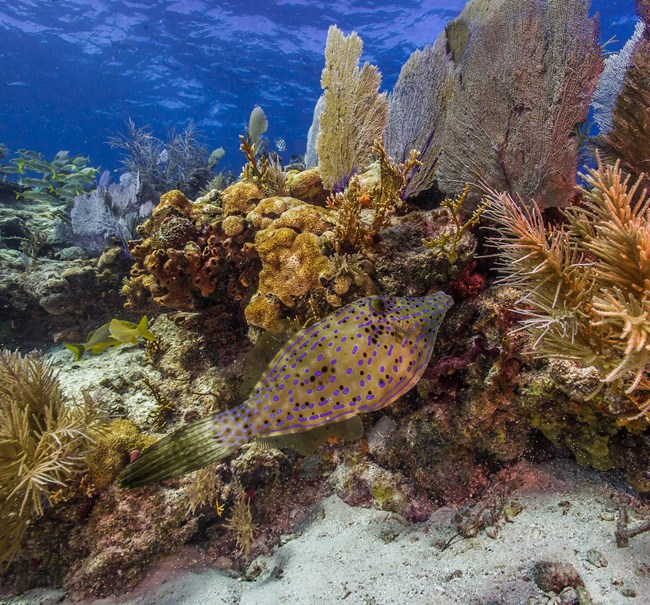Last updated: June 17, 2024
Article
NPS Geodiversity Atlas—Biscayne National Park, Florida
Geodiversity refers to the full variety of natural geologic (rocks, minerals, sediments, fossils, landforms, and physical processes) and soil resources and processes that occur in the park. A product of the Geologic Resources Inventory, the NPS Geodiversity Atlas delivers information in support of education, Geoconservation, and integrated management of living (biotic) and non-living (abiotic) components of the ecosystem.

Introduction
Biscayne National Park (BISC) is a collection of subtropical islands (keys), coastline, and coral reefs located in the northernmost Florida Keys and southern Biscayne Bay in Miami-Dade County, Florida. Originally authorized as a national monument on October 18, 1968, the park unit was redesignated and expanded on June 28, 1980 (National Park Service 2016b). Situated immediately south of Miami, BISC contains approximately 69,998 hectares (172,971 acres) and protects the longest stretch of mangrove forest along Florida’s east coast, part of the world’s third-longest barrier reef ecosystem, and the clear shallow waters of Biscayne Bay and the Atlantic Ocean. The reef system at BISC represents the northern end of the Florida Reef, an extensive 275 km (170 mi)-long coral barrier reef tract that includes Dry Tortugas National Park. The biological and hydrologic resources of BISC are an integral part of the South Florida ecosystem and include mangrove coasts, fragile coral reefs, estuarine bays, and important marine nursery habitats that sustain abundant and diverse native fisheries (National Park Service 2018). The cultural history of BISC dates back thousands of years and includes early occupation by Native Americans, Spanish and English exploration, pirates, shipwrecks, maritime smuggling, agriculture, and modern commercial development.
Geologic Setting
BISC is situated within the Florida Keys and Southern Atlantic Coastal Strip subsections of the Atlantic Coastal Plain physiographic province, a topographically low and geologically young region consisting of subtropical coast and keys underlain by unconsolidated, Cenozoic sedimentary deposits. The oldest rocks mapped at or near the surface of BISC are carbonate rocks of the Pleistocene Key Largo Limestone, a geologic unit named after exposures on Key Largo that widely occurs along the Florida Keys (Sanford 1909). Of the more than 40 keys that are located within BISC, the majority are comprised of Key Largo Limestone. The Pleistocene Miami Limestone occurs in western BISC along the mainland coast of Biscayne Bay and was named after nearby Miami, Florida by Sanford (1909). The youngest geologic units within the national park are Holocene surficial deposits that include carbonate mud, marl underlain by peat, and bay muck (organic matter, carbonate mud, and marl).
Regional Geology
Biscayne National Park is a part of the Coastal Plain Physiographic Province and shares its geologic history and some characteristic geologic formations with a region that extends well beyond park boundaries.
- Scoping summaries are records of scoping meetings where NPS staff and local geologists determined the park’s geologic mapping plan and what content should be included in the report.
- Digital geologic maps include files for viewing in GIS software, a guide to using the data, and a document with ancillary map information. Newer products also include data viewable in Google Earth and online map services.
- Reports use the maps to discuss the park’s setting and significance, notable geologic features and processes, geologic resource management issues, and geologic history.
- Posters are a static view of the GIS data in PDF format. Newer posters include aerial imagery or shaded relief and other park information. They are also included with the reports.
- Projects list basic information about the program and all products available for a park.
Source: NPS DataStore Saved Search 2723. To search for additional information, visit the NPS DataStore.
A NPS Soil Resources Inventory project has been completed for Biscayne National Park and can be found on the NPS Data Store.
Source: NPS DataStore Saved Search 2776. To search for additional information, visit the NPS DataStore.

Related Links
